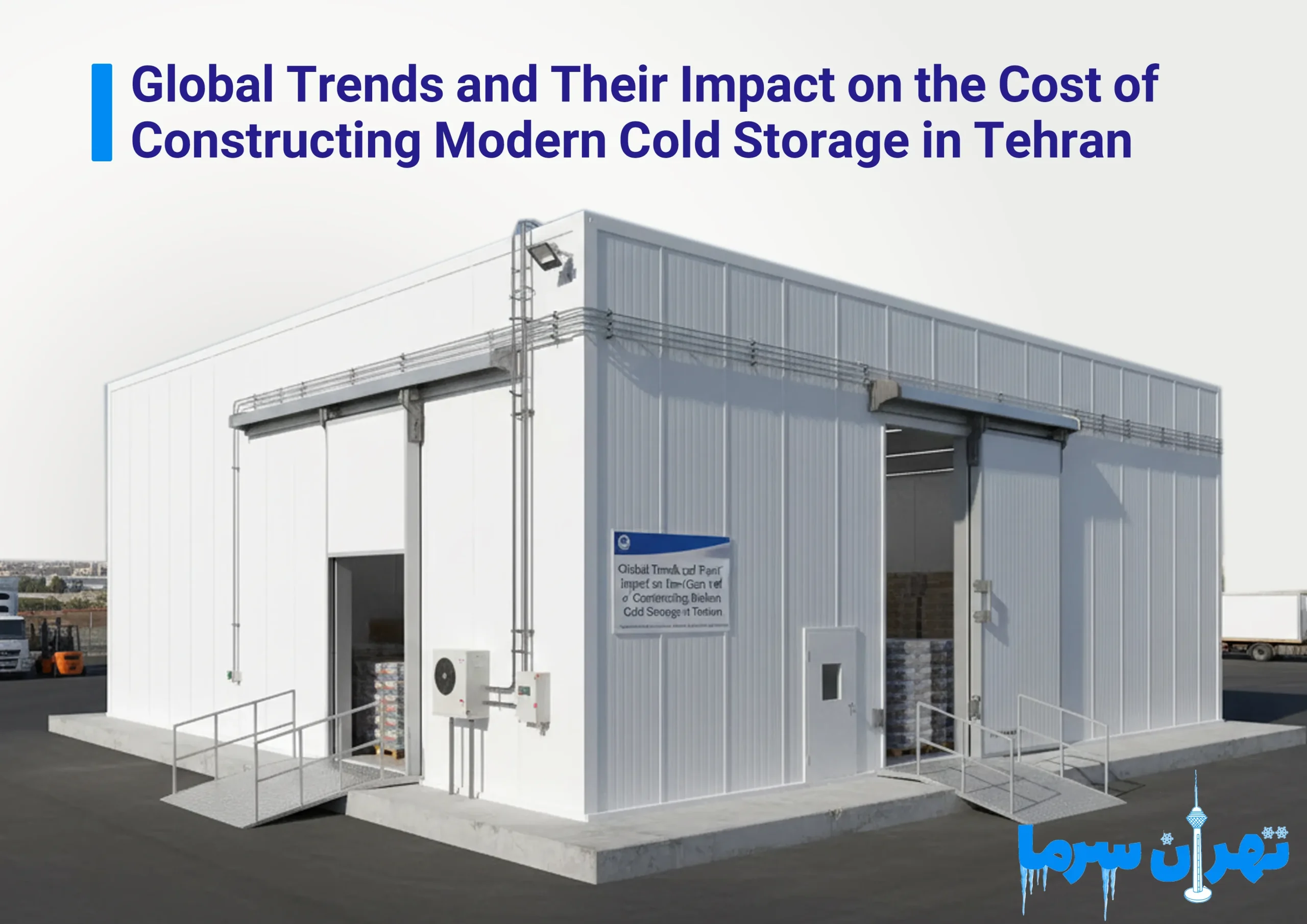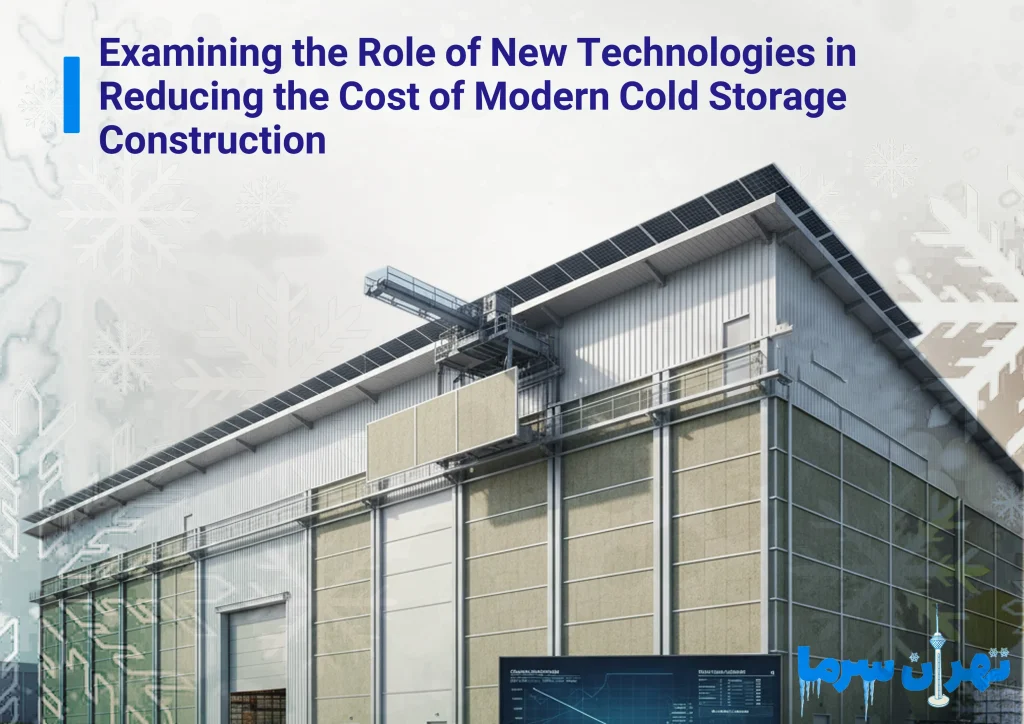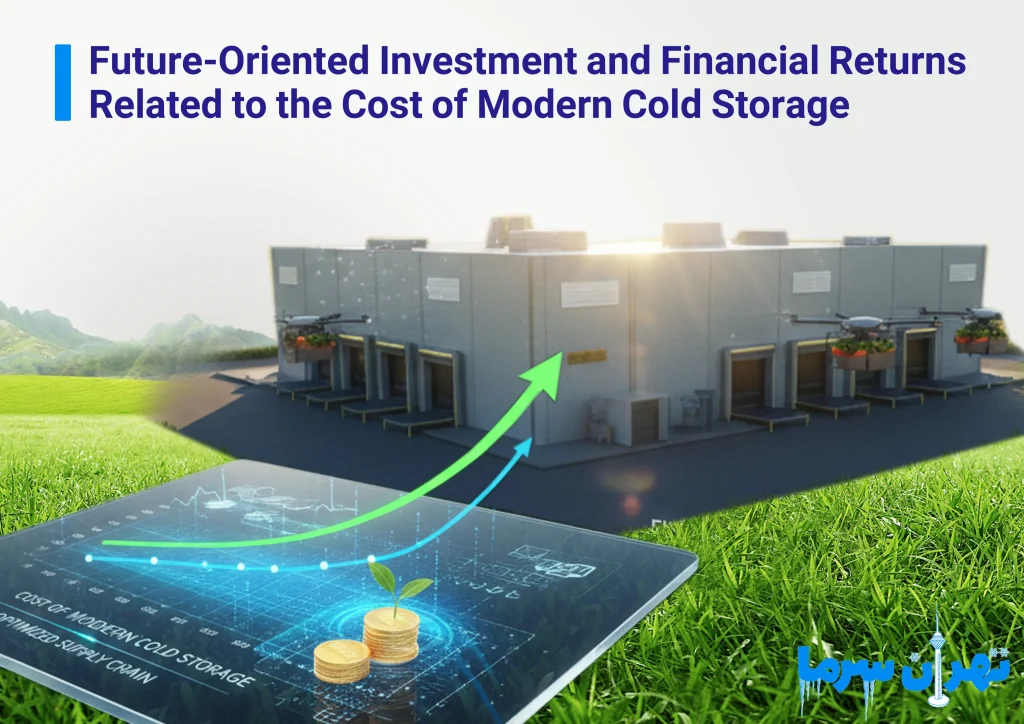Global Trends and Their Impact on the Cost of Constructing Modern Cold Storage in Tehran

The cost of constructing modern cold storage depends on a set of technical and operational factors. For this reason, the price of building a modern cold storage facility cannot be fixed and varies for each project based on the client’s requirements and the execution conditions. Moreover, the cost of constructing modern cold storage in Tehran is usually different from other cities due to the specific characteristics of this region.
Global trends across various industries, particularly in cooling equipment and food storage, have had a significant impact on the cost of constructing modern cold storage in Tehran. In recent years, the development of new technologies in insulation, refrigeration systems, smart control, and energy efficiency has led to changes in global standards for cold storage construction. These global changes are not limited to improving quality and efficiency but also directly affect construction costs. This is because the production and supply of modern equipment are influenced by international markets, and any fluctuation in the global prices of raw materials or related technologies can ultimately impact the cost of constructing modern cold storage in Tehran.
On the other hand, as a densely populated metropolis and the economic center of the country, Tehran has an increasing demand for advanced cold storage facilities. The import of cutting-edge technologies and equipment into the city has enabled cold storage projects to be executed in accordance with global standards. However, keeping up with these trends is inevitably costly, and fluctuations in currency rates, import tariffs, and international trade policies further increase the total project costs. Therefore, it can be said that globalization, while enhancing the quality and efficiency of Tehran’s cold storage facilities, has also affected construction costs.
One of the most important effects of global changes in this field is the growing attention to energy conservation and the reduction of environmental pollutants. Many countries are replacing old systems with smart and energy-efficient equipment. Although these technologies offer long-term benefits, they require higher investment during the construction and installation phase. As a result, the cost of building modern cold storage in Tehran has increased in line with the adoption of these technologies. Nevertheless, industry owners have realized that the initial costs are offset over time through energy savings and extended equipment lifespan, reinforcing a long-term investment perspective in this sector.
Another notable aspect of global trends is the rising worldwide demand for controlled storage of food and pharmaceutical products. International crises, climate change, and growing consumer market demand have led to the establishment of new standards for storing food and pharmaceuticals. Adhering to these standards in Tehran is unavoidable, directly impacting the cost of constructing modern cold storage. To meet international standards, cold storage manufacturers are often required to use technologies and raw materials that are imported and subject to global market fluctuations.
In summary, global trends present a double-edged sword for the cold storage construction industry in Tehran. On one hand, these trends have improved quality, increased efficiency, and aligned facilities with international standards. On the other hand, economic pressures arising from dependency on global markets have raised construction costs. Therefore, estimating the cost of constructing modern cold storage in Tehran is no longer a simple calculation based on capacity and area; it requires careful consideration of global developments, new technologies, and international economic policies. This highlights the necessity for industry owners and investors to remain aware of global trends, alongside local conditions, in order to make smarter decisions for the future.
Examining the Role of New Technologies in Reducing the Cost of Modern Cold Storage Construction
Examining the role of new technologies in reducing the cost of constructing modern cold storage has attracted considerable attention from refrigeration and cooling industry professionals in recent years. The introduction of new technologies in this field is not limited to quality improvement; it also has a direct impact on reducing operational and construction costs.
One of the most significant areas where modern technology plays a role is advanced insulation and the use of modern materials. These insulating materials greatly reduce energy loss, thereby decreasing the electricity consumption of the refrigeration system over the long term. This energy saving translates directly into a reduction in overall project costs.
In addition to insulation, smart refrigeration systems and next-generation compressors significantly contribute to lowering the cost of constructing modern cold storage. These devices, with optimized design and lower energy consumption, have longer lifespans and reduce the need for frequent maintenance and repairs. Although the initial cost of such technologies may be higher compared to older equipment, over the long term, energy savings and reduced repair expenses quickly offset the initial investment. In fact, new technologies have changed the traditional view of cold storage construction costs, transforming it from a heavy expense into a profitable investment.
Another important factor is advanced control and automation systems. Today, the use of smart sensors, remote control software, and precise monitoring of temperature and humidity enables optimal cold storage performance management. These systems allow for the early detection of potential issues and prevent costly breakdowns. Consequently, incidental costs due to equipment failure or product spoilage are minimized, playing a key role in reducing overall construction and operational costs.
Furthermore, attention to renewable and clean energy in cold storage projects is another example of how new technologies reduce costs. Using solar panels to supply part of the electricity or implementing heat recovery systems not only helps lower operating costs but also makes the cold storage facility more environmentally compliant. Over the long term, this significantly reduces energy-related expenses and potential fines from non-compliance with international standards.
Overall, examining the role of new technologies shows that reducing the cost of constructing modern cold storage is not merely about lowering initial expenditures. Rather, it involves intelligent management of ongoing costs and improving efficiency throughout the facility’s lifespan. By balancing initial costs with long-term savings, new technologies allow investors to enjoy high-standard cold storage while maintaining cost control. Therefore, it can be said that the future of the modern cold storage construction industry depends on the smart utilization of new technologies.
Here’s the English translation of your text, keeping the structure, headings, and details consistent with your original Persian version:
Comparing the Cost of Constructing Modern Cold Storage with Traditional and Older Cold Storage Facilities
Comparing the cost of constructing modern cold storage with traditional and older facilities shows that, although the initial investment in modern cold storage is higher, in the long term they offer greater economic benefits, efficiency, and productivity. Traditional and older cold storage units are generally built using simpler materials and older technologies and typically lack smart temperature and humidity control systems. Despite lower construction costs, these types of cold storage require higher energy consumption and continuous maintenance, which increases operational expenses and reduces overall efficiency. In contrast, modern cold storage facilities, equipped with advanced equipment, optimized insulation, and smart control systems, not only reduce energy consumption but also have a longer lifespan, significantly lowering maintenance and repair costs.
One of the fundamental differences between modern and traditional cold storage is the type of insulation used. Older facilities typically employ basic materials and initial standards, which significantly increase energy loss. As a result, refrigeration systems must work harder to maintain the desired temperature, consuming large amounts of energy. This not only increases electricity costs but also puts additional stress on the equipment, reducing its useful life. Modern cold storage, on the other hand, uses advanced insulation and energy-saving technologies to minimize electricity consumption and significantly reduce operational costs.
Refrigeration systems also create a major distinction between these two types of cold storage. Older compressors and equipment usually have lower efficiency and may be prone to long-term breakdowns. Consequently, maintenance and repair costs increase. Modern cold storage, utilizing optimized compressors and intelligent systems, reduces energy consumption, extends equipment lifespan, and decreases the need for frequent repairs. These features ensure that the higher initial investment in modern cold storage is compensated over time, making it economically more viable.
Another important aspect of this comparison is product storage quality. Older facilities, lacking precise temperature and humidity control, may cause spoilage or reduced quality of food and pharmaceutical products. This not only generates additional costs for industry owners but also results in significant economic losses. Modern cold storage facilities, adhering to international standards and using intelligent systems, provide optimal product preservation and prevent resource wastage.
Ultimately, comparing the cost of modern cold storage with traditional and older facilities is not limited to initial expenses. Considering long-term costs, energy efficiency, equipment lifespan, and product storage quality demonstrates that, despite higher upfront costs, modern cold storage is a more economical and intelligent choice over time. This enables investors to reduce operational costs, increase efficiency, and achieve higher profitability while keeping pace with modern technologies.
The Impact of Health Regulations and Standards on the Cost of Modern Cold Storage Construction
The impact of health regulations and standards on the cost of constructing modern cold storage can be examined from multiple perspectives and plays a critical role in determining project expenses. In recent years, global attention to food and pharmaceutical quality and safety has increased, prompting countries to establish stricter standards for the design and operation of cold storage facilities. Complying with these standards requires advanced equipment, high-quality materials, and precise temperature and humidity control systems, all of which directly increase construction costs.
Furthermore, health regulations often require documentation, periodic testing, and official approvals from relevant authorities, adding additional project expenses. In Tehran, due to population density and the economic importance of cold storage for the food and pharmaceutical industries, adherence to health standards is mandatory. This means that even when using materials and equipment similar to older facilities, compliance with new regulations increases the cost of constructing modern cold storage. However, this cost increase is accompanied by long-term benefits; compliance reduces product spoilage, extends equipment lifespan, and improves energy efficiency, ultimately making the investment more economical. From this perspective, health regulations and standards are not only legal and ethical obligations but also play a strategic role in cost management and quality improvement, encouraging investors to design and execute projects with higher efficiency and safety in the long term.
Future-Oriented Investment and Financial Returns Related to the Cost of Modern Cold Storage
Future-oriented investment and financial returns related to the cost of modern cold storage are of particular importance, as current investment decisions directly affect the long-term profitability and efficiency of projects. Choosing a modern cold storage facility over traditional and older structures, although possibly involving higher initial costs, allows the use of advanced technologies, smart control systems, optimized insulation, and energy-efficient equipment, significantly reducing operational costs and extending equipment lifespan. This ensures that the initial investment yields greater returns over time while minimizing resource wastage.
Moreover, future-oriented design and construction of modern cold storage must consider potential changes in market conditions, consumer demands, global standards, and technological developments, as these factors directly influence construction costs and investment returns. By anticipating demand growth, energy price fluctuations, and regulatory requirements, investors can make optimal decisions that not only reduce project risk but also create additional revenue opportunities.
Additionally, leveraging new technologies and designing according to international standards ensures that modern cold storage can maintain high-quality food and pharmaceutical products, creating added economic value for industry owners. This illustrates that forward-looking investment is not merely about reducing costs and increasing financial returns but also about forming a comprehensive strategy for resource management, efficiency improvement, and sustainable profitability. Ultimately, understanding the relationship between modern cold storage construction costs and associated financial returns allows investors to make informed, strategic decisions that yield high economic value and long-term sustainability.
The Most Suitable Cost of Cold Storage Construction with Tehran Sarma Engineering Company
The most suitable cost for cold storage construction with Tehran Sarma Engineering Company is achieved through experience, expertise, and the use of modern technologies in designing and executing cold storage projects. By carefully evaluating the client’s needs, desired capacity, and type of products to be stored, the company provides solutions that optimize both quality and operational and maintenance costs. Utilizing advanced equipment, standard insulation, and smart control systems ensures that the initial investment yields long-term economic returns, while energy and repair costs are reduced.
Additionally, Tehran Sarma’s specialized consulting in material selection and cold storage design guarantees that projects are executed in accordance with international standards and health requirements. Ultimately, clients can achieve a sustainable and economically efficient investment with the most suitable construction cost.
The cost of modern cold storage construction is always of special concern to investors and industry owners, as it directly impacts the overall project budget. In fact, the cost of building modern cold storage depends on various factors. In Tehran, due to the unique conditions of this metropolis—such as higher labor wages, equipment transportation costs, and space limitations—construction costs are generally calculated differently from other regions of the country.
Source:
https://www.procore.com/de




 سردخانه
سردخانه برق
برق کمپرسور
کمپرسور کمپرسور بیتزر
کمپرسور بیتزر کمپرسور کوپلند
کمپرسور کوپلند کمپرسور بوک
کمپرسور بوک کمپرسور دانفوس
کمپرسور دانفوس کمپرسور منیروپ دانفوس
کمپرسور منیروپ دانفوس کمپرسور امبراکو
کمپرسور امبراکو کمپرسور پاناسونیک
کمپرسور پاناسونیک کمپرسور سابکول
کمپرسور سابکول کمپرسور کوپلند
کمپرسور کوپلند کمپرسور اسکرال کوپلند
کمپرسور اسکرال کوپلند کمپرسورفراسکلد
کمپرسورفراسکلد کمپرسور رفکامپ
کمپرسور رفکامپ کمپرسور اسکرال دانفوس
کمپرسور اسکرال دانفوس گاز مبرد
گاز مبرد گاز R22
گاز R22 گاز R134
گاز R134 گاز R404
گاز R404 گاز R407
گاز R407 گاز R410
گاز R410 گاز R508
گاز R508 کندانسور هوایی
کندانسور هوایی اواپراتور
اواپراتور اواپراتور آرشه
اواپراتور آرشه اواپراتور صابکول
اواپراتور صابکول اواپراتور آسه
اواپراتور آسه اواپراتور نیک
اواپراتور نیک اواپراتور آرتک
اواپراتور آرتک اواپراتور نوین
اواپراتور نوین اواپراتور تبادل کار
اواپراتور تبادل کار درب
درب ساندویچ پنل
ساندویچ پنل فن سردخانه
فن سردخانه روغن کمپرسور سانیسو
روغن کمپرسور سانیسو متعلقات سردخانه
متعلقات سردخانه